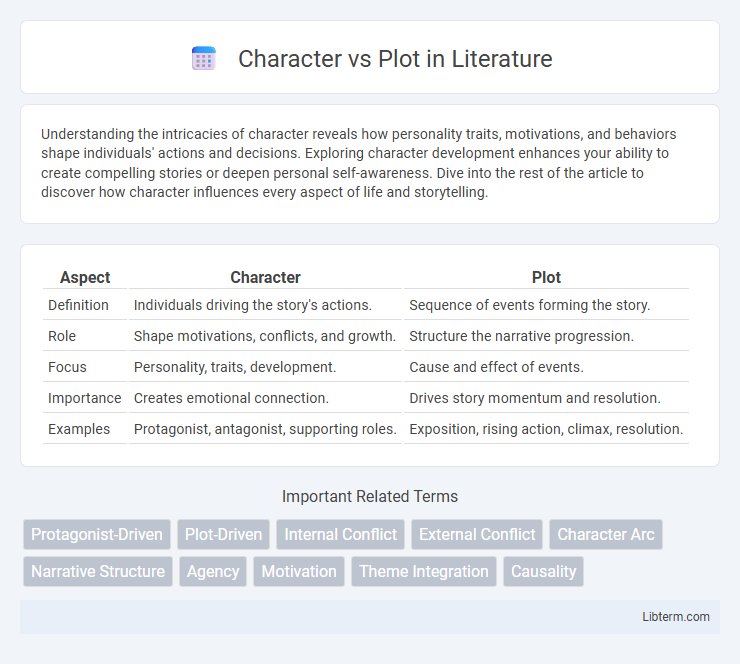Understanding the intricacies of character reveals how personality traits, motivations, and behaviors shape individuals' actions and decisions. Exploring character development enhances your ability to create compelling stories or deepen personal self-awareness. Dive into the rest of the article to discover how character influences every aspect of life and storytelling.
Table of Comparison
| Aspect | Character | Plot |
|---|---|---|
| Definition | Individuals driving the story's actions. | Sequence of events forming the story. |
| Role | Shape motivations, conflicts, and growth. | Structure the narrative progression. |
| Focus | Personality, traits, development. | Cause and effect of events. |
| Importance | Creates emotional connection. | Drives story momentum and resolution. |
| Examples | Protagonist, antagonist, supporting roles. | Exposition, rising action, climax, resolution. |
Understanding Character vs Plot
Character and plot represent two fundamental elements of storytelling, where character refers to the people, their traits, motivations, and development, while plot is the sequence of events driving the story. Understanding character versus plot involves recognizing that dynamic characters influence the plot through their decisions and growth, making the narrative compelling and coherent. Effective storytelling balances complex character arcs with a well-structured plot to create emotional engagement and thematic depth.
Defining Character-Driven Stories
Character-driven stories prioritize the development, motivations, and inner conflicts of characters over external events or plot twists, allowing personal growth and emotional depth to shape the narrative trajectory. These stories often explore complex relationships and psychological dynamics, emphasizing how characters' decisions and transformations drive the unfolding of events. By centering on character arcs, character-driven narratives create immersive, relatable experiences that resonate emotionally with audiences beyond conventional plot mechanics.
Exploring Plot-Driven Narratives
Plot-driven narratives emphasize event sequences and external conflicts to propel the story forward, often prioritizing thrilling twists and actions over character development. These stories rely on tightly constructed plots with clear goals, obstacles, and resolutions that maintain reader engagement through suspense and pace. While characters may be less complex, their choices and reactions serve primarily to advance the plot's momentum and thematic structure.
Key Differences Between Character and Plot
Character drives the story by embodying personalities, motivations, and growth that influence the narrative's emotional depth. Plot outlines the sequence of events and actions that structure the storyline, providing a framework for conflict and resolution. The key difference lies in character focusing on internal development, while plot emphasizes external progression.
The Role of Character Development
Character development drives narrative engagement by fostering emotional connections and motivating plot progression. Well-crafted characters reveal themes and conflicts organically, allowing the plot to unfold through their decisions and growth. This dynamic interplay ensures a compelling story where character arcs shape and enrich the overall storyline.
The Importance of Plot Structure
Plot structure provides a framework that drives the narrative forward by organizing events and conflicts into a coherent sequence, ensuring pacing and tension are maintained. Effective plot structure enhances character development by placing protagonists in challenges that reveal their motivations, growth, and transformation. Strong story arcs structured with rising action, climax, and resolution engage audiences, making the narrative both compelling and easy to follow.
Balancing Character and Plot
Balancing character and plot involves creating dynamic characters whose decisions drive the narrative forward, ensuring the story remains engaging and cohesive. Characters must have clear motivations and arcs that intertwine seamlessly with key plot developments, enhancing emotional investment and thematic depth. Effective storytelling leverages this synergy to maintain pacing while delivering meaningful conflicts and resolutions.
Common Mistakes in Character vs Plot
Common mistakes in character versus plot include creating characters who merely serve the plot without personal motivations or growth, leading to flat and unrelatable figures. Overemphasizing plot events often causes character development to stagnate, making emotional engagement difficult for readers. Balancing character agency with plot progression ensures characters drive the story organically rather than being passive plot devices.
Examples from Literature and Film
Character-driven stories like F. Scott Fitzgerald's "The Great Gatsby" emphasize the inner motivations and development of protagonists, such as Gatsby's pursuit of the American Dream. Plot-driven narratives, exemplified by films like "Inception," focus on complex events and twists that propel the storyline forward with an intricate structure. Literary works like Charles Dickens' "Great Expectations" blend both elements, using Pip's character growth alongside a compelling sequence of events to create a balanced narrative.
Choosing the Right Focus for Your Story
Choosing the right focus for your story hinges on whether character development or plot progression drives the narrative. Stories centered on character focus explore internal conflicts, personal growth, and emotional arcs, creating deep connections with readers through relatable motivations and transformations. Plot-driven stories emphasize external events, structured sequences, and cause-and-effect dynamics that propel the story forward, making pacing and tension crucial elements to master.
Character Infographic

 libterm.com
libterm.com